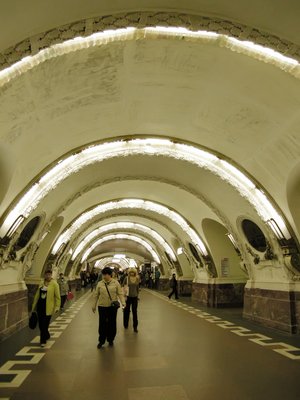
The Ploshchad' Vosstaniya station is a typical example of the St. Petersburg Metro station: less ornate than those of Moscow, but still, on the whole, remarkably spacious and well-designed.

The St. Petersburg Metro, eclipsed by its more extensive and decorated Muscovite cousin, nevertheless stands as another example of Soviet urban transit policy and planning. Its stations are less elaborate than those in the Moscow system, though still, on the whole, much more spacious and aesthetically appealing than subway stations in the United States. Those I have seen are mostly large, white-ceilinged halls, making them feel somewhat less cavelike despite their great depth beneath the city streets. They, as well, use marble and bronze extensively, though perhaps less dramatically so than in Moscow. While perhaps not as emblematic of Soviet ideology as the Moscow Metro, the design of the Petersburg Metro system was clearly meant to signify that the existence of the system was a measure of progress, and trips on it something to be thought of positively, as glimpses of the mechanized, ideal society that was to be built.
Moreover, it forms a central role in Petersburg transit, though, more so than in Moscow, that role is necessarily augmented by trams, trolleybuses, and buses. This is because the stations in St. Petersburg are, on average, quite farther apart than those in Moscow, often making it impractical or unappealing to travel exclusively by metro. Therefore, transfers are standard fare for travel within the city, facilitated by no-cost transfers (in most cases) from the Metro to surface transit. This reflects the level of difficulty and expense involved in expanding or adding more stops to the St. Petersburg Metro: because the lines run considerably farther underground than those in Moscow, it is often more practicable to create new surface transit instead.
Still, especially in light of the ever-increasing car traffic, the Metro is crucial in allowing residents of St. Petersburg to travel across the city in a timely manner; accordingly, travel by the Petersburg Metro is and has been increasing steadily for the last three decades. (Kaple 56–61, O'Grady)


Traveling on the Petersburg Metro was roughly the same experience as that in Moscow: trains arrived often, and trips were efficient and timely. One somewhat-unique feature of the St. Petersburg Metro are the doors present at each platform, with which the train aligns its doors, meaning one steps seamlessly from the platform onto the train, without first having gotten sight of it. Although initially designed the prevent people from falling onto the tracks, the system also proves useful in that you know precisely where the doors will be along the platform, allowing you to stand there in anticipation of the train, as well as more easily get out of the way of those departing from each car. This proves a more smooth experience, then, then in Moscow or other subways on which I have ridden.
Again, as in Moscow, there seems to be a clear need to expand and renovate the system: there are entire sections of St. Petersburg which are not served by the Metro, and which depend on the increasingly-unpopular trams for longer trips. Moreover, the number of vehicles running during commuting times is clearly insufficient, leading to quite excessive crowding of the vehicles. Further, the relatively poor quality and reliability of other forms of mass transit in St. Petersburg exacerbate the insufficient service of the Metro.